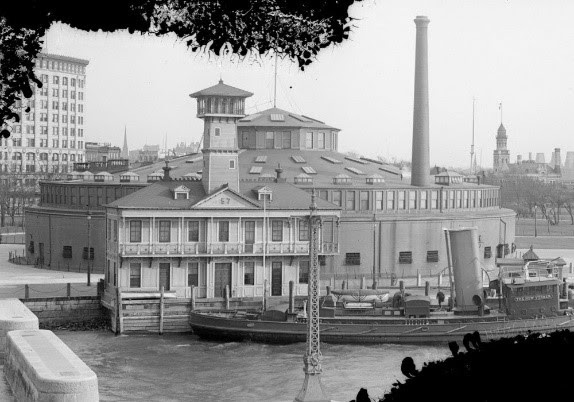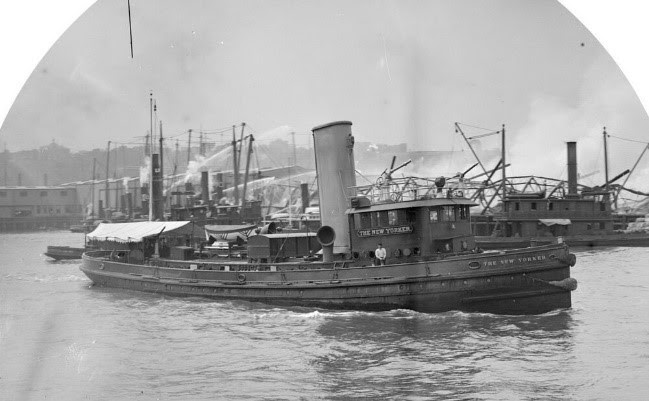Weekend, December 18-19, 2021 – THEY ARE HERE TO SAVE LIVES AND PROPERTY WITH RIVER WATER



RIHS/NYPL ZOOM PROGRAM ON
TUESDAY, DECEMBER 21, 2021 AT 6:30 P.M.
WITH
MELINDA HUNT, FOUNDER OF THE HART ISLAND PROJECT
UPDATE ON HART ISLAND
HART ISLAND, THE HOME OF THE NYC MUNICIPAL CEMETERY HAS HAD MANY CHANGES IN THE LAST FEW YEARS. THE ISLAND IS NOW ADMINISTERED BY THE NYC PARKS DEPARTMENT.
https://www.nypl.org/events/programs/2021/12/21/rihs-lecture-hart-island
FROM THE ARCHIVES
WEEKEND, DECEMBER 18-19, 2021
THE 549th EDITION
Fireboats of New York City
Stephen Blank

As if you didn’t already know, the Port of New York is a pretty big place. It’s bounded by some 650 miles of developed shoreline of 5 boroughs and 7 New Jersey towns. At the peak of its activity, just after WWII, it contained 600 individual ship anchorages, piers and warehouses. It was serviced by a fleet of 575 tugboats. It was watched over by a sturdy team of fireboats.
Fireboats have been around for a long time. The City’s first official purpose-made fireboat dates to 1875, but, decades earlier, in 1809, New York City volunteer firefighters first mounted a crude hand-operated pump on a small boat. This was the beginning of the American fireboat.
Early fireboats were familiar, post-Civil War steam-powered tugboats found in many harbors. Although not specifically intended for fireboat duty, some were fitted with steam-operated pumps and nozzles with wide flexibility for auxiliary fireboat use. Their new equipment was more efficient than hand-operated pumps but the problem was that these early tugboat fireboats were not always available when needed. Also, since they were usually equipped with a single boiler, it was difficult to maneuver and to pump water at the same time.
In 1865, the Metropolitan Board of Fire Commissioners took over the management of the Fire Department and discussed the need for a “floating engine to fight fires on and along the river fronts.” They signed a contract in 1866 with John C. Baxter & Son, owners of the steam salvage tug John Fuller, for the services of the boat on a “call basis” at a yearly rental.

Fuller served the Department for more than nine years, until the first city-owned fireboat was put in service in 1875. At first, when Fuller was needed at a fire, a messenger was sent from Fire Headquarters in Mercer Street to her West Street dock, with orders to respond. The first fire at which the “floating engine” operated as a unit of the Department was on October 16, 1866, at 307 West Street, close to her berth. In his report to the Commissioners for the year 1866, Chief Elisha Kingsland wrote that the contract for the use of the Fuller had proven most satisfactory.
The need for fireboats escalated with the expansion of America’s ports and waterfronts because of the significant fire risks they posed, and cities began buying purpose-made fireboats. In 1873, the Boston Fire Department commissioned the William F. Flanders, the first American steam-powered fireboat. This was followed a year later when the New York Commissioners contracted for the construction of a fireboat priced at $23,800. When placed in service on May 12, 1875, the boat, named William F. Havemeyer, was berthed at the foot of Pike Street, East River, and Engine Company 43 was organized to man her, with two officers, two engineers, pilot and five firemen – all quartered on board. Havemeyer remained in service until 1901.

Drawing of the “William F. Havemeyer”, Harper’s Weekly, Nov 11, 1882
Even with an “official” Fire Department fireboat, competition still seems to have broken out with unofficial fire fighters. The Harper’s Weekly Havemeyer story reports this: “An amusing incident in the career of the fire-boat happened a few years ago, upon her return from a short excursion down the bay, with a party of Western chief engineers of fire departments on board. An elevator in Brooklyn was on fire, and several tug-boats were throwing streams of water upon it. As the Havemeyer approached, with a view of rendering assistance, and at the same time showing the Western visitors of what she was capable, the tugs directed the several streams against her for the purpose of driving her off. Instead, however, of leaving she turned two of her powerful streams upon them, and within five minutes had the field to herself having completely deluged her opponents. She then went to work and subdued the fire, to the great admiration of her guests.”
A second fireboat, Zophar Mills, was built in 1882 and placed in service on April 14, 1883 as Engine 51 and berthed at Pier 42, North River. Zophar Mills was the first iron hull fireboat and served the Department for 52 years, until 1934.

883 Drawing of Zophar Mills, John Landers – Beth Klein Collection

Zophar Mills was the first (or second) fireboat to respond to the General Slocum fire
The most powerful and most famous of these early fireboats was New Yorker, placed in service on February 1, 1891. She was the first New York fireboat with a steel hull and the first with a shore station. Its architecturally distinctive station near Castle Garden became a landmark as famous as the boat itself.
Fireboat “New Yorker,” tied up at the Station House, c. 1910; Fireboat, “New Yorker,” 1903. Department of Docks and Ferries Collection. NYC Municipal Archives
| New Yorker was the most powerful fireboat in the world. When Admiral Dewey came to New York with the flagship “Olympia” after the battle of Manilla Bay, New Yorker led the water parade of hundreds of craft. After its storied career, the New Yorker was taken out of service in 1931. The firehouse was reaching the end of its days and Battery Park was about to be closed for several years while the Brooklyn-Battery Tunnel was built. Engine 57 was moved to then Pier 1 in 1941. Fireboats commissioned after 1896 established the model on which the modern fireboat is designed. The new fireboats were equipped with multiple, high capacity boilers. They were faster and capable of delivering large volumes of water at high pressures without affecting the boat’s maneuverability. The new fireboats designed for one purpose: to deliver large volumes of water at high pressures during a fire. The internal combustion engine was first introduced into fireboats in 1918. But the gasoline engine didn’t last long because of concerns about explosions. By 1927, many of the steam and gasoline powered fireboats had been decommissioned or were overhauled and retrofitted with more efficient and economical diesel engines or diesel/electric powered motors and pumps. By replacing steam with diesel and diesel electric power sources, boat designers were able to incorporate multiple engines and pumps into the same space occupied by large steam boilers, steam engines, and pumps. For the first time, propulsion and pumping systems could be separated, allowing fireboats to maneuver and pump at the same time. This separation of systems solved the problem that early versions of the fireboat had experienced being in the dangerous situation of choosing between propulsion and pumping. At its peak, in the early 1900’s, the FDNY Marine Division had 10 fireboat stations within the city. Budget cuts in the late 1960’s and 1970’s reduced the fleet to 4 Marine Companies. The role played by fireboats on 9/11 deserves an entire article. But in brief, when the towers came down, the water mains in Lower Manhattan around the area of the towers were all destroyed, so fireboats pumped water ashore to the land companies so they could battle the fires. The John J. Harvey, a small fireboat built in 1931, over three days straight pumped 38 million gallons into the city. The fireboats were a part of a larger boatlift operation with some 150 vessels from tug boats and ferries to the Coast Guard and New York Police Department boats. Hundreds of mariners on the water that day helped to evacuate nearly 500,000 people. Fireboats remained in support for nearly two weeks. Following 9/11, the department recognized the continued value of a fire boat fleet and developed plans for upgrading the fleet to meet the needs of the future. In the 2010 and 2011, three new and powerful boats entered service. The older boats have either gone into reserve status or retirement. Today, the FDNY operates the most modern and powerful fire boats in the world. The two “big” boats, the “Three Forty Three” and the nearly identical “Fire Fighter II” are significantly larger than all older boats and can pump twice the water. The city got its money’s worth out of those older boats. The “Three Forty Three” replaced the “John D. McKean,” christened in 1954 and “Fire Fighter II” replaced the “Fire Fighter,” christened in 1938. A third boat “The Bravest” is the fastest of the fleet, cruising at 50 knots when needed. The newest of the big boats, named for the Deputy Commissioner killed on 9-11, “William M. Feehan,” was delivered in the fall of 2015. |
| Stephen Blank RIHS December 11, 2021 |

William M. Feehan, Courtesy MetalCraft Marine
WE ARE OFF FOR A FEW DAYS, SO JUST HOLD YOUR BREATH TO SEE IF YOUR ANSWERS WERE CORRECT!
WEEKEND PHOTO
SEND YOUR ANSWER TO:
ROOSEVELTISLANDHISTORY@GMAIL.COM
OR JBIRD134@AOL.COM

FRIDAY PHOTO OF THE DAY
Infamous Women’s House of Detention.

SOURCES
https://www.capecodfd.com/pages%20special/Fireboats_FDNY_09_Old-M9.htm
https://www.usfa.fema.gov/downloads/pdf/publications/tr-146.pdf
http://marine1fdny.com/fireboat_history_new.php
https://www.archives.nyc/blog/2021/4/30/building-history-part-2
https://coffeeordie.com/fdny-fireboats/
Funding Provided by:
Roosevelt Island Corporation Public Purpose Funds
Council Member Ben Kallos City Council Discretionary Funds thru DYCD
Text by Judith Berdy
Edited by Deborah Dorff
ALL PHOTOS COPYRIGHT RIHS. 2020 (C)
PHOTOS IN THIS ISSUE (C) JUDITH BERDY RIHS


Copyright © 2021 Roosevelt Island Historical Society, All rights reserved.Our mailing address is:
rooseveltislandhistory@gmail.com



Leave a comment